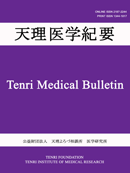Current issue
Displaying 1-11 of 11 articles from this issue
- |<
- <
- 1
- >
- >|
Original Article
-
2023 Volume 26 Issue 2 Pages 76-82
Published: December 25, 2023
Released on J-STAGE: December 25, 2023
Download PDF (782K) Full view HTML -
2023 Volume 26 Issue 2 Pages 83-88
Published: December 25, 2023
Released on J-STAGE: December 25, 2023
Download PDF (821K) Full view HTML -
2023 Volume 26 Issue 2 Pages 89-98
Published: December 25, 2023
Released on J-STAGE: December 25, 2023
Download PDF (1238K) Full view HTML
Case Report
-
2023 Volume 26 Issue 2 Pages 99-109
Published: December 25, 2023
Released on J-STAGE: December 25, 2023
Download PDF (4886K) Full view HTML -
2023 Volume 26 Issue 2 Pages 110-115
Published: December 25, 2023
Released on J-STAGE: December 25, 2023
Download PDF (4602K) Full view HTML
2022 Symposium of the Tenri Institute of Medical Research
-
Article type: 2022 Symposium of the Tenri Institute of Medical Research
2023 Volume 26 Issue 2 Pages 117
Published: December 25, 2023
Released on J-STAGE: December 25, 2023
Download PDF (330K) -
Article type: 2022 Symposium of the Tenri Institute of Medical Research
2023 Volume 26 Issue 2 Pages 118
Published: December 25, 2023
Released on J-STAGE: December 25, 2023
Download PDF (258K) -
Article type: 2022 Symposium of the Tenri Institute of Medical Research
2023 Volume 26 Issue 2 Pages 119
Published: December 25, 2023
Released on J-STAGE: December 25, 2023
Download PDF (236K) -
Article type: 2022 Symposium of the Tenri Institute of Medical Research
2023 Volume 26 Issue 2 Pages 120-122
Published: December 25, 2023
Released on J-STAGE: December 25, 2023
Download PDF (1970K) -
2023 Volume 26 Issue 2 Pages 123-131
Published: December 25, 2023
Released on J-STAGE: December 25, 2023
Download PDF (2778K) Full view HTML
Pictures at Bedside and Bench
-
2023 Volume 26 Issue 2 Pages 132-136
Published: December 25, 2023
Released on J-STAGE: December 25, 2023
Download PDF (1854K) Full view HTML
- |<
- <
- 1
- >
- >|
